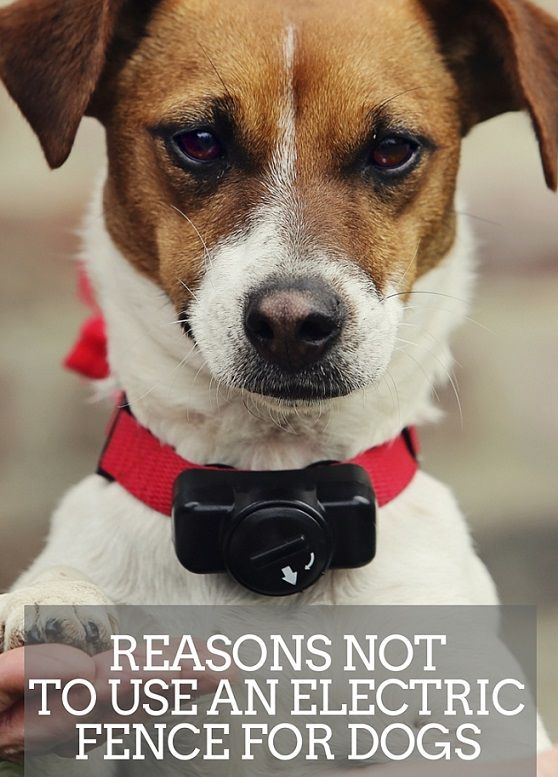This post will go over some reasons NOT to use an electric fence for dogs.
I’m actually a fan of electric fences for dogs, either the underground “invisible” fence variety or the newer, wireless versions. You can read one of my posts in support of electronic fences here.
(I know the correct term is electronic fence, but most people incorrectly say electric).
Electronic fences have worked well for my family’s dogs over the last 15 years, allowing our dogs years of off-leash freedom. This allowed them to be a much more central part of our lives because they got to be out with us.
You might wonder:
Why would you need an electric fence?
Why not just put up a physical fence?
For us, there are two reasons:
- It would not be practical to put up a physical fence around the whole property. It’s too much space. This would be too expensive and would also look bad.
- My parents live on lakefront property. It wouldn’t make sense to fence in the back yard with a physical fence because it’s right on the lake.
Still, there are some issues with electric fences, so I thought I’d address some of them here.
Using a shock/e-collar is NOT one of my reasons. There’s nothing wrong with e-collars when used properly. The “correction” is used to get the dog’s attention and is not meant to cause pain. It’s similar to a vibrating cellphone – a bit startling!
If you’re worried about the intensity of the correction, always test it on yourself first (I always do). If e-collars make you uncomfortable, don’t use them! No one said you have to use them! See my post: Using shock collars for dog training.
Some reasons not to use an electric fence for dogs
(Most of these can be avoided with proper, consistent training)
1. Dogs can get out of electronic fences.
There’s always that chance that your dog is going to run right through the boundary after something he can’t resist such as a prey animal or a family member or a cat or whatever it might be. Proper training can help decrease the chances, but in reality some dogs get out of electric fences.
How to prevent this:
- Don’t leave your dog out in the fence when you’re not home so you can check in on your dog.
- Test the e-collar’s battery every day.
- Brush up on training every week.
*There’s always a chance dogs can get out of any physical fence as well. Dogs can climb over, dig under or break through a fence. Plus, a neighbor or contract worker or child could leave the gate unlocked or wide open by accident. In some ways, electronic fences are more reliable than physical fences. Every dog and every situation is different. No fence is 100 percent reliable.
**I hear a lot of arguments about the high numbers of lost/stray dogs that have gotten out of electronic fences. There are no statistics on this but I would argue there are far more dogs that get out of physical fences or slip their collars than there are dogs that get out of electric fences.
2. Dogs can get out and might be scared to re-enter the electric fence’s boundary.
If your dog does happen to cross the boundary, he might be afraid to re-enter because he would likely receive a second “correction” for re-crossing the boundary. This may not be the case with ALL systems (I’m not sure), but the dog might still be afraid to re-cross regardless.
3. Electronic fences can quit working as with any electronic device.
With anything electronic, there’s always that chance for malfunction. The battery could die, there could be a power outage (most have a battery backup but that can malfunction too) or the system could just break for whatever reason.
 4. Electric fences don’t keep other pets/animals/people out.
4. Electric fences don’t keep other pets/animals/people out.
Sometimes the point of a fence is to keep neighbor dogs or neighbor kids out of your yard for whatever reason. Without a barrier, obviously other animals and people have easy access to your yard and your dog. This could be a problem if your dog is aggressive to strangers or if neighbor dogs/stray dogs are aggressive to your dog.
How to avoid this:
Only have your dog in the yard when you’re able to supervise. Keep him inside when you’re not home.
5. Electric fences require dedicated, consistent training.
Some dogs need two weeks to a month to fully understand the electric fence system. The training process is actually very simple, but it does require time and consistency from the owner’s part like all training. You can’t just slap the collar on your dog and expect him to figure it out.
The training process involves setting up training flags to mark the boundaries and putting the collar on warning tone only. Using a leash, walk your dog to the boundary until you hear the warning tone. Use a command like “get back” and move back with your dog, rewarding him with food and praise. “Good boy!” See my full post on training a dog to use an electronic fence.
What are some other reasons I’ve missed?
Do you use an electronic fence for your dog?
Let me know in the comments!
Related posts:
Review of the Motorola Wireless Fence
Yes I use shock and prong collars
Review Motorola TravelFence50
Reasons to use electric fences for dogs




Lauren Brody
Tuesday 5th of April 2016
Everyone is entitled to their opinion and what works for 1 dog does not work for another. I have lived on 5 properties over the past 20 years, and the last 4 have had invisible fences. The first had a physical fence. My Portuguese water dog got out of the yard no less than 30 times when we only had a physical fence. Gardeners and pool people would leave the gate open, she could dig under, etc. It was a nightmare. When we moved we installed an invisible fence. The Portie ONLY got out when the collar battery died (she was that smart, she knew the lack of beep meant she was good to go). If she heard the beep, she stayed put. Now I have 3 dogs and they were all properly trained and NONE of them even consider approaching the barrier. We have a fenced backyard, and the whole property is electronically fenced. It provides 2 levels of safety for the dogs. Bottom line, if you train the dogs properly, stay on top of batteries, the fence works. I HIGHLY recommend it. No, it does not prevent other dogs. But is this a problem for most people? Dogs running onto your property? It is a non issue where I live. Dogs running across the fence and afraid to return? Do dogs who run out of an open gate usually come right back? Again, proper training and the dogs are NOT going over the line. Be smart and evaluate your property and your dogs. Then decide what is best for you.
Lindsay Stordahl
Tuesday 5th of April 2016
Exactly, Lauren! My thoughts as well.
Nancy's Point
Thursday 25th of February 2016
I love our electronic fence. Just love it and so have our dogs. It was easy to train the dogs on how to use it and we have had few issues. I agree with the comment above that sometimes it can be annoying to walk by a house with a fence line that is too close to the road, but still, this might be better than having a dog chase you out onto the street. And just because you have an electronic fence, this doesn't mean you can let your dog out any old time and not worry about what they do out there. Responsible dog owners don't do that. And the fence lines should be set back from the road a ways, especially if you have a big yard and this is feasible.
Emma
Tuesday 23rd of February 2016
Nope. Mom worries with a real fence, she would never let us out with an invisible one. We are not fans because we have seen it far too often when dogs just bust out and start chasing us down. Lots of our non dog friends have also asked us about how they work as they too have been scared to pass homes where dogs act like they will kill but there is no visible fence. I'm sure they are great for some dogs, but we are not fans.
Kimberly Gauthier
Tuesday 23rd of February 2016
I don't use an electric fence on our property, because it's too big. We considered adding them to certain spots to keep the dogs from going to the neighbor's property or out on the Centennial Trail, but I don't have confidence that it would work and this is still a lot of space to cover.
So I've been working on training their recall and teaching them to come to me when they see bicycles. It's working.
Melissa
Tuesday 23rd of February 2016
I have an electric fence but I hate it. I have broken it twice by gardening. My dog has broken through it twice, not sure how since I know she must have gotten shocked. Plus we back up to 88 acres of forever wild woods with suburban animals living back there. I worry about them coming up and hurting our dog. We seriously took bids to put in a real fence but it is too much money for us right now. I wish we could afford it. I agree with Sean in his comment above about other dogs in their yards charging at us right up to the end of their property and scaring the daylights out of us on our walks. Plus another two different dogs have broken through their electric fences and attacked us on our walks. Sorry, but I would have all dogs behind a real fence if it was possible, even my own.
Lindsay Stordahl
Tuesday 23rd of February 2016
I can understand where that frustration comes from. Thankfully my family's dogs have never broken out of their electronic fence, even the springer spaniel who has a high prey drive. She has gone through it only when she wasn't wearing her collar. I do see the frustration of dogs charging up to the boundaries and scaring the daylights out of people. I've experienced that as a dog walker. You never know if the dogs are actually going to stop at the boundary or if there even is a boundary! I think it's best to have the fence as far back from the road as possible, several yards ideally.